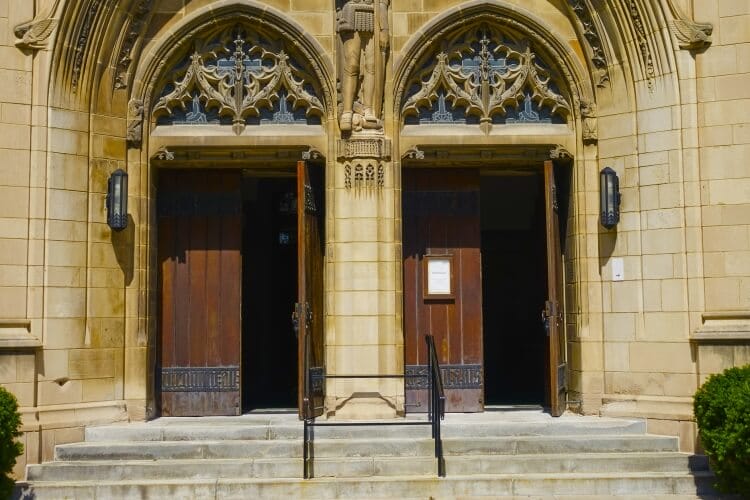Assessing Cultural Beliefs In Feng Shui

What inspired this article topic was a recent project for a client in the Middle East. I noticed on the floor plan that there were two front doors and my hunch was that this might have to do with the client’s religion or cultural beliefs.
Sure enough, this design of having two front doors on opposite sides of the facing wall was intentionally placed for men and women to enter the house separately. We know in classical Feng Shui that the door is paramount as a gateway or portal to bring the outside energies and qi inside. In the design phase, we want to place the door in one of the best possible locations, but two doors may compromise that. And yet, it is relatively common for a house to have more than one door, so we can definitely incorporate this cultural practice into a Feng Shui design.
Cultural Beliefs Have a Role in Feng Shui
One entrance might ultimately be considered better than another, but we can also factor in who is using the door, their gender, their position in the family and their occupation to ultimately compare the two entrances.
I’ve been to homes where there were two kitchens, to accommodate certain dietary restrictions. The ancient kitchen was a source of fire primarily, although the modern kitchen hosts a literal ton of metal. Still, the concept of cooking and what kind of energy is surrounding the food while in preparation can be a factor in the analysis. Religious symbols are like art in that they are subjective, but they can be powerful and inspiring in their own way. Feng Shui principles would never disallow someone to place in their home a meaningful symbol, nor should anyone be expected to decorate their home with images that they cannot identify with. This is something I can’t emphasize enough since the trendy hype years of the 1990’s made people think they needed to embrace Chinese or Buddhist symbols to have good energy.
Other cultures have their version of Feng Shui principles, even if not identified as such. As one example, in the East-Indian practice of Vaastu Shastra, there are theories about where a kitchen should be placed, the location of other rooms as well and even a preference for northeast facing houses, to greet the rising sun.
Some religions dictate where the home altar or prayer room should be located. Some groups advocate having the altar tucked away in a private room where guests would not congregate. Other groups mandate that the altar is a certain height above the ground. I have never encountered a situation where good Feng Shui needed to be undermined for the sake of a religious or cultural belief, except someone burning devotional candles in an area that should not have the fire element present. Many years ago I had a client who told me she lit a hundred candles nightly as part of the religious ritual.
For some, taking their shoes off in the house is preferred. This is just a good habit for other reasons, not the least of which is that the bottoms of your feet need a certain amount of direct stimulation every day. With 72,000 nerve endings on the bottom of the feet, reflexology recommends that we allow the feet to get that kind of direct contact with the floor to have a good effect on the internal organs, nervous system, and circulatory system.
Cultural Beliefs and Spiritual Traditions May Merge
Even though we may take individual spiritual traditions and cultural beliefs and practices into consideration in the design or use of a house, there are also some distinct features which are welcome to a place of worship like a church or temple, which would not be appropriate for a home and vice versa. Classical Feng Shui notes the precise compass reading for any structure and those built exactly on the exact middle degree of the cardinal directions are best for churches and temples. These exact cardinal directions are 90 degrees East, 180 degrees South, 270 degrees west and 0 degrees North.
Even what we call cardinal directions will normally have a 15-degree span, such as the South WU direction spanning 172.5- 187.5 degrees or east MAO direction spanning from 82.5 degrees to 97.5 degrees. So in other words, having a house which sits magnetic east at 95 degrees is not the same as 90 degrees for the recommendation just mentioned.
If a house were to sit exactly at 90 degrees, this is different than 85 or 95 degrees. Precisely situated in the cardinal directions can encourage a structure to be more of a vortex of spiritual energy, or so I’ve heard!
Because magnetic fields change, usually slowly, over long periods of time, it is sometimes relevant to find out what the magnetic declination was in an area at the time the structure was built. Thanks to the Internet and websites like the Geophysical Data Center website, this information is now much easier to obtain and corroborate than ever before.
Click HERE to Connect with your Daily Horoscope!
About the Author
Connect with Kartar Diamond and Kartar’s School of Traditional Feng Shui® at fengshuisolutions.net
Kartar Diamond grew up in Southern California in the 1970’s and always had an interest in metaphysics and holistic lifestyle choices. She met Master Sang in 1992 became one of his senior graduate instructors from the American Feng Shui Institute. Kartar founded her own company, Feng Shui Solutions, and has advised thousands of clients and students about the healthful benefits of this still greatly misunderstood practice.









